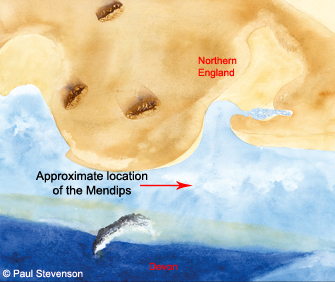
Ancient environments
Silurian l Devonian l Carboniferous l Triassic l Jurassic
The Carboniferous, 359 – 299 million years ago
Tropical reefs

At the end of the Devonian the sea spread across the Mendip area, marking the beginning of a long phase of limestone deposition. Initially, muddy sediments accumulated (Avon Group) in shallow, turbid waters, but gradually the reef limestones that are characteristic of the Carboniferous Limestone (Pembroke Limestone Group) became predominant. The environment in which these rocks formed was analogous to the Bahamas today, with tropical, warm, clear shallow water conditions covering the Mendip region in the early Carboniferous.
Sandstone deltas
Deposition of the Carboniferous Limestone was abruptly terminated by the southward spread of sandy sediment that today forms the Quartzitic Sandstone Formation. This sandstone formed part of a delta complex, built out by rivers that drained a landmass (St George's Land) to the north of the Mendip region.
Coal swamps
Throughout the Upper Carboniferous the river deltas that now covered the Mendip region were densely colonised by lush forests of giant tree ferns, horsetails and club mosses. River channels meandered through the forest and periodically the delta was flooded by the sea. Thick peat deposits formed in this tropical swamp, eventually becoming buried and transformed into coal.
Life in the early Carboniferous | Life in the late Carboniferous
- Home
- Overview maps
- Locality
areas
- Cheddar Gorge
- Charterhouse
- Blackdown
- Burrington Combe
- Shipham & Rowberrow
- Crook Peak & Axbridge
- Banwell to Churchill
- Priddy
- Harptree & Smitham Hill
- Draycott & Westbury-sub-Mendip
- Wookey Hole & Ebbor Gorge
- Wells
- Great Elm & Vallis Vale
- Mells & the Wadbury Valley
- The Vobster area
- The Whatley area
- Torr Works & Asham Wood
- Beacon Hill
- Stoke St Michael & Oakhill
- Holwell & Nunney
- Shepton Mallet & Maesbury
- Gurney Slade & Emborough
- The Nettlebridge valley
- Geology
- Minerals and mines
- Quarrying
- Caves and karst
- Biodiversity
- Detailed site information
- Acknowledgements
- External links
- Search
- Site map